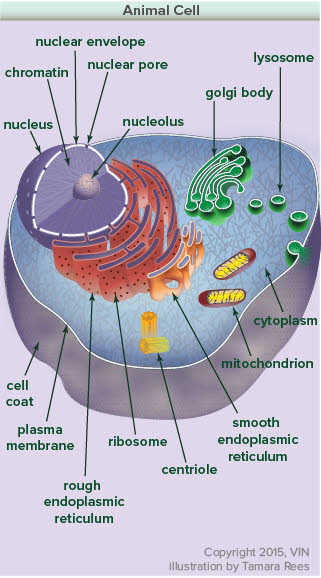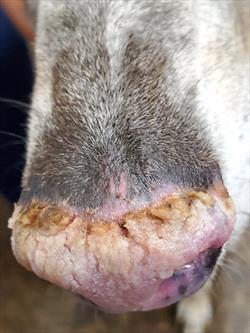Discoid Lupus on a Nose

Photo courtesy of MarVistaVet.
(Also called DLE, Nasal Solar Dermatitis, or Collie Nose)
Lupus – What is this Disease?
Lupus is an immune-mediated disease stemming from your own immune system reacting against your own DNA. This in itself sounds like a recipe for disaster since almost every cell in a body has DNA in it, but it is important to remember that under normal circumstances, your DNA is sequestered in a cell nucleus where the antibodies of the immune system cannot reach it. The immune system in lupus does not attack every cell in the body to get to its DNA; instead, the immune system only sees DNA after cells have died and their assorted broken parts are floating around as debris. The immune system reacts to this loose DNA and generates antibodies. These antibodies:DNA complexes deposit in delicate membranes, such as the kidney filtration membranes, blood vessel linings, joint capsules, and other similar structures. Once caught in these membranes, other immunologic cells are attracted, and further inflammatory damage results.
Systemic lupus (SLE) involves this kind of inflammatory disruption (called a Type III hypersensitivity reaction), and the prognosis depends on which organ systems are affected and how severe the damage is. The disease is not curable but is manageable with immuno-suppressive drugs.
The name “lupus” stems from archaic times when the disease was thought to have been caused by the bite of a wolf.
Animal Cell

Illustration by Tamara Rees
Systemic Lupus Versus Discoid Lupus
When people use the term lupus, they are referring to systemic lupus, or SLE as described above. Discoid lupus is a form of lupus that is confined to the skin and is substantially more benign because of this confinement. Discoid lupus, or DLE, is almost exclusively a canine disease and is almost always limited to the leather of the nose, called the nasal planum.
Features of Discoid Lupus (DLE)
The immune system in lupus does not attack every cell in the body to get to its DNA; instead, it only sees DNA after cells have died and their assorted broken parts are floating around as debris.
DLE does not progress to SLE.
Lesions of DLE are almost always limited to the nose, though they can extend up the bridge of the nose and sometimes affect the ears or inside the mouth. Early signs of the condition start with the loss of nose pigment. A black nose will become bluish-grey or even pink. Scaling and cracking of the skin result, and eventually, the nose will ulcerate. Exposure to sunshine makes the condition worse, and there seems to be a genetic predisposition among the collie breeds (hence the term collie nose).
Discoid Lupus on a Nose

Photo courtesy Dr. Carol Foil
There are several other conditions that also cause crusts and/or erosions on the nose, so it is important to get the right diagnosis. Some other conditions to rule out include:
- Dermatophytosis (ringworm of the nose)
- Mucocutaneous pyoderma (Staph infection on the bridge of the nose - see later)
- Pemphigus foliaceus (a different immune-mediated skin disease)
- Hyperkeratosis (a callusing disease of the nose)
- Nasal lymphoma (a type of cancer)
- VKH-like syndrome (another immune-mediated disease)
Diagnosis is by biopsy, which means a small piece of nose tissue must be harvested and sent to the laboratory for analysis. Most dogs will not hold still for this kind of procedure on their nose, so sedation is generally needed to get proper samples.
Expect stitches afterward; some mild bleeding is possible. Diagnosis also involves some important historical information such as whether other body areas are involved, whether the condition is constant or comes and goes, and what medications have helped in the past. The pathologist will consider all of this information along with the microscopic appearance of the tissue.
Because mucocutaneous pyoderma looks just like discoid lupus, even under the microscope, some steps are likely to be needed to distinguish the two conditions. A good month of antibiotics generally resolves mucocutaneous pyoderma, so it may be necessary to culture the nose and obtain an antibiotic profile with this plan in mind. Culture could be done in conjunction with biopsy or prior, depending on how infected the nose appears. Discoid lupus will not respond to antibiotics and will need immune suppression, hopefully topically but possibly orally.
Discoid Lupus on a nose

Photo Courtesy Marvistavet Graphics
Therapy Choices
Discoid lupus is a condition with many treatment options depending on the severity of symptoms.
Avoid Strong Sunlight
Since this condition is made worse by the sun, it is important to avoid intense sunlight. Sunscreens have been advocated but it is important to realize that there are toxic ingredients in many human sunscreens and anything you apply to a dog’s nose will be licked off. Pet sunscreens are expected to be licked. Various products for sun protection for your pet do exist: ask your veterinarian for any recommendations they may have.
Topical Corticosteroids
The immune-suppressive effects of steroids are helpful in DLE but the systemic side effects are undesirable. Side effects are minimized by using topical steroids, typically starting twice a day and eventually dropping to an as-needed basis for maintenance after the nose is healed.
Tetracycline/Niacinamide
Tetracycline is an antibiotic with immunomodulating properties separate from its antibiotic properties. Niacinamide (also called nicotinamide) is a B vitamin supplement related to niacin (vitamin B3). The combination of these two medications has been found effective in 70% of dogs with DLE, though it can take up to two months to see an effect. Treatment is given three times daily, which is relatively inconvenient for most people, so alternatives have been sought. Doxycycline can be used twice a day and is frequently substituted for tetracycline as tetracycline is very difficult to obtain.
Prednisone/Prednisolone
Oral steroids are often used to get the condition under control relatively quickly (within a month) and can be used after that as the sole therapy after the lowest effective maintenance dose is determined. Side effects include panting, excessive thirst and urination, and increased appetite. None of these effects are particularly desirable, so often steroids are used in conjunction with one of the other therapies with the idea of dropping back the steroids when the second therapy can take over.
Oral Cyclosporine
Cyclosporine is an immunomodulator that has found extensive use in veterinary medicine for a number of immune-mediated conditions, including allergies. It can be used to control DLE but has some potential for side effects (mostly upset stomach) that might not be worthwhile for milder cases.
0.1% Tacrolimus (Protopic®)
This is a topical immunomodulator made for human use. It is very effective for use in DLE and does not cause problems if licked. Only small amounts of ointment are needed, and the tube should last a long time, which is good news since it is not inexpensive. The person applying the medication should wear gloves to avoid unneeded exposure.
If your dog is diagnosed with discoid lupus, discuss therapy options with your veterinarian. If your dog has a crusty or ulcerated nose, expect a biopsy to be needed to sort out the diagnosis properly before treatment can be prescribed.